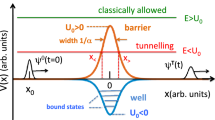Abstract
Reflection and transmission times through a linear potential is studied by using the stationary phase method. The incident particle is described by a wave packet constructed from a momentum distribution δ(k′ − k) highly concentrated around a fixed value k. The way the reflection and transmission times are calculated is similar to the way the phase time τϕ is defined for a rectangular potential.
Similar content being viewed by others
REFERENCES
Abramovitz, M. and Stegun, I. (1970).Handbook of Mathematical Functions, Dover, New York.
Cohen-Tanoudji, C., Diu, B., and Laloë F. (1977). QuantumMechanics, Vol. 1, Wiley, Paris, p. 81.
de Aquino, V. M., Aguilera-Navarro, V. C., Goto, M., and Iwamoto, H. (1998). Physical Review A 58, 4359.
Erdélyi, A. (1956). Assymptotic Expansions, Dover, NewYork.
Hartman, T. E. (1962). Journal of Applied Physics 33,3427.
Hauge, E. H. and Støvneng, J. A. (1989). Review of ModernPhysics 61, 91.
Landauer, R. and Martin, Th. (1994). Review of Modern Physics 66, 217.
Muga, J. G. and Leavens, C. R. (2000). Physics Report 338,353.
Wigner, E. P. (1955). Physical Review 98, 145.
Author information
Authors and Affiliations
Rights and permissions
About this article
Cite this article
Goto, M., Iwamoto, H., de Aquino, V.M. et al. Reflection and Transmission Times Through a Linear Potential. International Journal of Theoretical Physics 41, 877–886 (2002). https://doi.org/10.1023/A:1015737024481
Issue Date:
DOI: https://doi.org/10.1023/A:1015737024481



